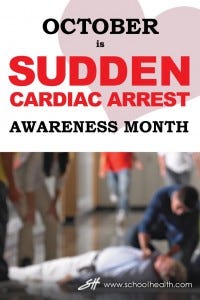Let’s Talk About Sudden Cardiac Arrest in Schools
- Oct 13, 2016
- 0 Comments
 Each year, approximately 7,000 children age 18 or younger experience sudden cardiac arrest outside a hospital with survival rates of less than 10 percent. Immediate CPR can double or triple someone’s chance of survival, which is important for schools since children spend at least one-third of their days in this environment.
Each year, approximately 7,000 children age 18 or younger experience sudden cardiac arrest outside a hospital with survival rates of less than 10 percent. Immediate CPR can double or triple someone’s chance of survival, which is important for schools since children spend at least one-third of their days in this environment.Yet only 34 states require CPR training and hands-on practice as a high school graduation requirement and just four mandate school planning for sudden cardiac arrest. That leaves 15 states and the District of Columbia without laws related to CPR, AEDs or cardiac emergency response plans (CERPs) in schools.
Last month, School Nurse published a policy statement from the American Heart Association advocating for state laws requiring the implementation of CERPs in K-12 schools. Cardiac Emergency Response Planning for Schools: A Policy Statement provides a national model for K-12 schools to develop, implement, practice and evaluate a CERP, while addressing the legal aspects and critical nature of training and drills in bringing a CERP to fruition.
The statement recommends that all schools have a CERP in place that contains the following minimum, evidence-based core elements:
- Establishing a cardiac emergency response team
- Activating the team in response to a sudden cardiac arrest
- Implementing automated external defibrillator (AED) placement and routine maintenance within the school (similar to fire extinguisher protocols)
- Disseminating the plan throughout the school campus
- Maintaining ongoing staff training in CPR/AED use
- Practicing using drills (akin to fire and lockdown drills)
- Integrating local EMS with the plan
- Ongoing and annual review and evaluation of the plan.
Monica Martin Goble, MD, AHA volunteer and pediatric cardiologist at the University of Michigan Congenital Heart Center, was co-chair of the working group that authored the paper. She says, “Every minute counts in sudden cardiac arrest. The safety of students, school staff and visitors will only be enhanced by school teams that feel empowered to administer lifesaving care until EMS arrives.”
A key component to high-quality CPR training is a psychomotor component, or hands-on training. Programs like the AHA’s CPR in Schools Training Kit™ enable students to learn the lifesaving skills of CPR in just one class period. Plus, the kit teaches AED use and choking relief. For school administrators interested in developing a plan, a CERP toolkit, including the policy statement and an accompanying “Policy-in-Brief” can be accessed at heart.org/cerp.
This October, we invite you to join the AHA and School Health as we work together to increase survival from sudden cardiac arrest, especially in school settings. #CPRSavesLives
